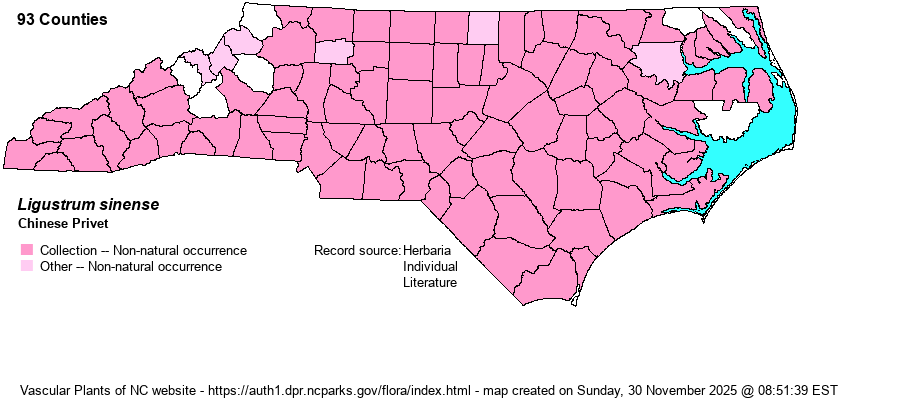| Author | Loureiro | |
| Distribution | Throughout the state, although seemingly absent from the northern Mountains. First collected in 1891. Next, in 1930 in Brunswick County, 1940 at Carolina Beach (New Hanover County), and 1942 in Henderson County. By the middle to late 1950s it had been collected nearly throughout.
Native of China; in N.A. MA, IL, and KS south to FL and TX; also AZ, OR. | |
| Abundance | Common to abundant throughout, except uncommon in most the Mountains and seemingly absent in the northern counties. This is one of the handful of worst invasives in NC, along with Lonicera japonica and Microstegium vimineum. Thousands of acres of floodplain forests and bottomlands now have a nearly solid layer of shrubs 4-8 feet high, eliminating most native flora beneath. Other floodplains and moist slopes are infested with short sprouts 3 feet or less tall. | |
| Habitat | Floodplain forests, river terraces, bottomland forests, streamside thickets, moist roadsides, urban and suburban thickets, disturbed woodlands. It normally is not a major problem in upland forests, but it can occur there; it can be difficult to find a bottomland forest of 100 acres or more without at least a few of these pernicious plants. |
| Phenology | Flowering May-June. It is a prolific producer of fruits, which birds and water spread about. | |
| Identification | Chinese Privet grows to be a tall shrub or small tree up to 30 feet tall; it is tardily deciduous to semi-evergreen. The leaves are opposite, elliptical, mostly 1-2 inches long and with a dull upper surface (contra L. vulgare and most others in the genus). Inflorescences are terminal, pyramidal, and overly fragrant. Telling this species from L. vulgare can be subtle; see Weakley's (2018) key for several characters. | |
| Taxonomic Comments | | |
| Other Common Name(s) | | |
| State Rank | SE | |
| Global Rank | GNR | |
| State Status | | |
| US Status | | |
| USACE-agcp | FAC link |
| USACE-emp | FACU link |

